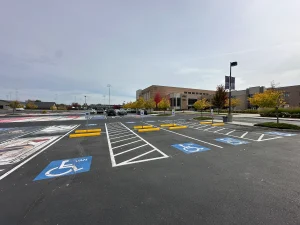How Often Should You Maintain Your Asphalt?
Asphalt surfaces require regular maintenance to stay durable, smooth, and safe. Without proper care, they can deteriorate quickly due to weather exposure, traffic, and everyday wear and tear. The key to extending the life of your asphalt and avoiding costly repairs is timely and consistent maintenance. But how often should you perform essential services like sealcoating, crack filling, striping, and patching?
In this guide, we’ll break down the ideal maintenance schedule for your asphalt, helping you protect your investment and keep your pavement looking great year-round.
1. Sealcoating – Every 2 to 3 Years
What It Does: Sealcoating is a protective layer applied to the surface of your asphalt, shielding it from water, oil, UV rays, and oxidation. It also restores the deep black finish, enhancing curb appeal.
Recommended Frequency:
-
New Asphalt: Wait at least 6 months to 1 year before the first sealcoat.
-
Existing Asphalt: Apply sealcoating every 2 to 3 years, depending on traffic and exposure to elements.
-
High-Traffic Areas: Parking lots with heavy traffic may need sealcoating more frequently, around every 1.5 to 2 years.
2. Crack Filling – As Soon as Cracks Appear
What It Does: Crack filling prevents water and debris from seeping into the asphalt, which can cause cracks to expand and lead to potholes or structural damage.
Recommended Frequency:
-
Inspect your asphalt twice a year (spring and fall) for new cracks.
-
Fill cracks as soon as they appear—do not wait, as small cracks can quickly become costly problems.
3. Patching & Pothole Repair – Immediately
What It Does: Patching repairs damaged sections of asphalt, including potholes, alligator cracks, and crumbling edges. Addressing these issues promptly prevents further damage and safety hazards.
Recommended Frequency:
-
Immediate repairs are necessary once damage is detected.
-
Conduct regular seasonal inspections (especially after winter) to identify and fix new potholes or deteriorated areas.
4. Parking Lot Striping – Every 1 to 2 Years
What It Does: Striping ensures parking lot lines, traffic markings, and ADA-compliant spaces remain visible and organized.
Recommended Frequency:
-
Every 1 to 2 years, depending on traffic and weather exposure.
-
If striping begins to fade or is difficult to see at night, reapply immediately.
-
After sealcoating, restriping is always necessary.
Seasonal Asphalt Maintenance Schedule
Spring (March – May)
✅ Inspect for cracks and potholes after winter freeze-thaw cycles.
✅ Schedule crack filling and pothole repairs.
Summer (June – August)
✅ Sealcoating (optimal time due to warm temperatures).
✅ Restripe parking lots if needed.
✅ Continue checking for cracks and new damage.
Fall (September – November)
✅ Inspect for cracks and repair before winter.
✅ Perform necessary patching before temperatures drop.
Winter (December – February)
✅ Monitor asphalt for damage caused by snow, ice, and plowing.
✅ Keep surfaces clear of debris and standing water.
Final Thoughts: Consistency Saves Money
Routine asphalt maintenance prevents expensive repairs and replacements. By following this recommended schedule for sealcoating, crack filling, striping, and patching, you’ll extend the life of your pavement and keep it safe and visually appealing.
Need Professional Asphalt Maintenance?
If your parking lot or driveway needs service, our expert team is here to help! Contact us today for a free consultation and keep your asphalt in top condition year-round.


